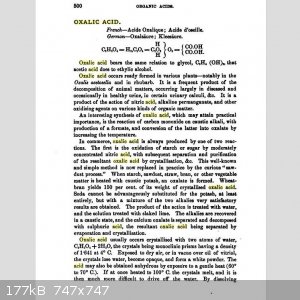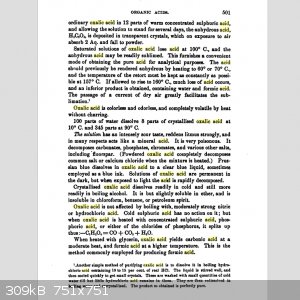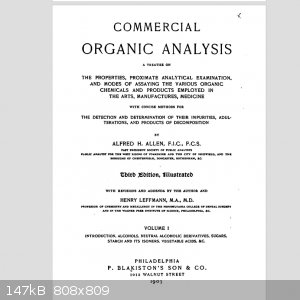| Pages:
1
2 |
Fulmen
International Hazard
    
Posts: 1693
Registered: 24-9-2005
Member Is Offline
Mood: Bored
|
|
Oxalate from formate?
I noticed something interesting on Wikipedia:
On heating, sodium formate decomposes to form sodium oxalate and hydrogen
Since I happen to have a few tons of the stuff at work I figured I could give it a try.
Some relevant literature:
https://www.researchgate.net/profile/Jerry_Kaczur/publicatio...
Apparently temperatures around 350-450°C should do the trick, either with straight formate or in combination with NaOH or Na2CO3. Doesn't sound to
hard to pull off...
We're not banging rocks together here. We know how to put a man back together.
|
|
|
Fulmen
International Hazard
    
Posts: 1693
Registered: 24-9-2005
Member Is Offline
Mood: Bored
|
|
This looks very promising. Here are some excerpts from the paper:
Levi and Pita(3) ... stated that formate began to decompose at 300°C, and that the decomposition is violent at 400°C, with the reaction complete
at 550°C. In later work, they also claimed that the use of small amounts of sodium hydroxide had a beneficial effect, producing technical grade
sodium oxalate below the melting point of sodium formate.
Leslie(4) reported the experimental work in determining the factors in the conversion of sodium formate to sodium oxalate. ... at 2 in. of Hg (6.8
kPa) at 26°C, 14 in. of Hg (47.4 kPa) at 300°C, and at atmospheric pressure (101 kPa) at 360°C, the optimum NaOH concentration ranged from about 1
to 2 wt% to obtain nearly quantitative conversion to oxalate.
Górski (9): The formate yields to oxalate in the various atmospheres did not exceed 54% with no catalyst or with the addition of sodium carbonate for
all three alkali metal formates. The addition of a base, such as NaOH to sodium formate, and KOH to potassium formate in a 1: 0.05 molar ratio
achieved a 92 – 93% conversion to the corresponding alkali metal oxalate. He also reported that the yield of sodium oxalate was shown to decrease as
the heating rate was lowered.
There are also some conflicting data:
Meisel’s(7) results showed a high variability with the shape and type of crucible holdersubstrates that were used, such as platinum, corundum,
aluminum oxide, and others.Meisel(7) could not achieve the oxalate high conversion yields reported in the literature.
We're not banging rocks together here. We know how to put a man back together.
|
|
|
Fulmen
International Hazard
    
Posts: 1693
Registered: 24-9-2005
Member Is Offline
Mood: Bored
|
|
I'm recrystallizing some HCOONa now, it's a real PITA but at least I don't have to worry about yields.
The conversion seems simple enough, my plan is to add 2-3% NaOH, melt it on a hotplate to ensure a uniform mixture and then put it in the furnace at
400°C. My biggest worry is the H2 produced. I don't have any N2 or other inert gases, and CO2 seems to lower the yield. Any good ideas to prevent my
furnace from blowing up?
Also, does anyone have suggestions for other uses for formates?
Calcium formate can apparently produce formaldehyde (https://library.sciencemadness.org/library/formaldehyde.html), and according to Goldschmidt tin formate decomposes almost quantitatively to
formaldehyde.
[Edited on 30-11-18 by Fulmen]
We're not banging rocks together here. We know how to put a man back together.
|
|
|
Fulmen
International Hazard
    
Posts: 1693
Registered: 24-9-2005
Member Is Offline
Mood: Bored
|
|
I noticed a slight smell of formaldehyde when drying the formate (120°C), this could be an issue as I don't have good ventilation for my furnace. At
least if I'm going to produce larger quantities. I'm having trouble finding much on this reaction, which I assume goes something like this:
2 HCOONa => H2CO + Na2CO3
I noticed that calcium formate decomposes at 300°C, while the conversion to oxalates requires temperatures around 400°C. Formaldehyde decomposes
from around 150°C (http://www.inchem.org/documents/hsg/hsg/hsg057.htm). Wikipedia mentions the "Cannizzaro reaction in the presence of basic catalysts to produce
formic acid and methanol", if I'm lucky the NaOH will suppress the formation of formaldehyde.
We're not banging rocks together here. We know how to put a man back together.
|
|
|
Fulmen
International Hazard
    
Posts: 1693
Registered: 24-9-2005
Member Is Offline
Mood: Bored
|
|
I did a preliminary test with 48,5g of NaOOCH and 1,5g NaOH, using a stainless beaker and a blow torch. After melting the melt started to produce
flammable gas that quickly caught fire. Within a few minutes the melt foamed up and formed a grayish/tan solid mass, at this point the heating was
discontinued. After cooling the mass was broken up and dissolved in appr. 350ml of 10% sulfuric acid with some slight effervescence. It was then
filtered and left to cool, forming a white precipitate.
I will leave it in the fridge overnight to ppt out, then we'll see what we've got. I figured I would try to form iron oxalate, that should be fairly
indicative.
We're not banging rocks together here. We know how to put a man back together.
|
|
|
Fulmen
International Hazard
    
Posts: 1693
Registered: 24-9-2005
Member Is Offline
Mood: Bored
|
|
I got a fair amount of precipitate (29,2g dried @80°C, 26,7g @120°C), the first to form was a fine white powder while larger, more transparent
crystals formed over night. I worry that the initial ppt could be Na2SO4, guess I should have used HCl.
I tested the filtrate with FeSO4, but got no ppt. So instead I ppt it with calcium nitrate and treated it with conc. HCl to redissolve the oxalic
acid. This gave me a slightly yellow solution (which I assumed were due to traces of iron). However, after heating it turned a strong orange color,
don't really know what that means yet.
We're not banging rocks together here. We know how to put a man back together.
|
|
|
Fulmen
International Hazard
    
Posts: 1693
Registered: 24-9-2005
Member Is Offline
Mood: Bored
|
|
Yay! I redid the experiment, dissolving the product in 200ml of 15% HCl. Rather than trying to dissolve the whole batch in one go I leached it
multiple times with the warm acid and precipitating it by cooling. The result was 27g of what I assume is the dihydrate. The iron test was positive
(insoluble orange ppt that produced pyrophoric iron on heating).
Yield was lower than the literature suggested, but that was expected considering the crude setup. No big deal really as sodium formate is cheap as
dirt.
We're not banging rocks together here. We know how to put a man back together.
|
|
|
Fulmen
International Hazard
    
Posts: 1693
Registered: 24-9-2005
Member Is Offline
Mood: Bored
|
|
Another batch, so far it seems like I got similar yields. I dropped the other batch on the floor, so no more results from that test. This time I hope
to test the product by weight loss during dehydration and finally on decomposition.
I do get a significant (several grams by the looks of it) of insoluble matter, which has me perplexed.
The only products I can think of are:
Sodium oxalate.
Sodium formate. Unlikely as no smell was noted during acidification. Also it's by far the most soluble candidate.
Sodium carbonate. The most likely candidate (as indicated by effervescence), most things end up there if anything goes wrong.
Sodium oxide/hydroxide. Unlikely and should end up as sodium chloride together with any carbonates.
Sodium chloride (after acidification). This is guaranteed to be present, but should be soluble enough to remove.
We're not banging rocks together here. We know how to put a man back together.
|
|
|
j_sum1
|
Thread Moved
6-12-2018 at 14:11 |
Fulmen
International Hazard
    
Posts: 1693
Registered: 24-9-2005
Member Is Offline
Mood: Bored
|
|
Dang, seems like I still have the sodium salt. That fits better with the solubility, but how do I convert it to oxalic acid? I was sure acidification
would do the trick.
We're not banging rocks together here. We know how to put a man back together.
|
|
|
Fulmen
International Hazard
    
Posts: 1693
Registered: 24-9-2005
Member Is Offline
Mood: Bored
|
|
I have tried to convert it again by dissolving it in a minimum of boiling water, then add conc. HCl until it dissolved. Sodium oxalate might be less
soluble, but the Ka of HCl is 103 greater than that of oxalic acid. Wouldn't that force oxalic acid out of solution?
Anybody? Helloooo? Am I talking to myself here?
We're not banging rocks together here. We know how to put a man back together.
|
|
|
AJKOER
Radically Dubious
    
Posts: 3026
Registered: 7-5-2011
Member Is Offline
Mood: No Mood
|
|
Look at the reference paper, a bit dated in terms of science.
A possible low temperature aqueous approach would be to first create the carbon dioxide radical anion from the hydroxyl radical acting on the formate
ion:
HCO2- (aq) + .OH --> H2O + .CO2- (see source below)
Then, speculation over the self reaction:
.CO2- + .CO2- =?= C2O4(2-)
Note, no air or oxygen presence as this is a known path to the superoxide radical anion:
O2 + .CO2- = .O2- + CO2
Source: See https://books.google.com/books?id=mckVFtJ7YecC&pg=PA14&a...
-------------------------------------------------
Paper: 'Reduction of carbon dioxide to oxalate by a binuclear copper complex' at https://www.ncbi.nlm.nih.gov/pubmed/25522935 .
See also: http://science.sciencemag.org/content/327/5963/313.full
[Edited on 9-12-2018 by AJKOER]
|
|
|
WGTR
National Hazard
   
Posts: 971
Registered: 29-9-2013
Location: Online
Member Is Offline
Mood: Outline
|
|
Hmmm...well, you could try taking some of the sodium oxalate and precipitating the oxalate with some calcium chloride. Then, collect the precipitate
and wash, and then with heavy stirring boil an excess amount with sulfuric acid solution. After some hours, filter out the excess calcium salts, and
evaporate down what’s left. I’m not sure if that would even work, but that’s all I’ve got. Google Books will be your friend on something
like this. Search for the free books and arrange them by date, then look for the ones from the late 1800’s or early 1900’s.
Edit: Just for fun, I took a cruise through Google Books. Perhaps boiling oxalic acid is a bad idea. Maybe this will help:
  
[Edited on 12-9-2018 by WGTR]
|
|
|
Fulmen
International Hazard
    
Posts: 1693
Registered: 24-9-2005
Member Is Offline
Mood: Bored
|
|
Thanks, that was useful. The calcium/sulfuric acid method is covered on page one, so that is definitively an option. But I was hoping to avoid the
extra work, and a quick test with more HCl shows promise. Heating the product to an red/orange heat produced appr. 20% residue, suggesting a fair
amount of oxalic acid present.
So my next step will be to try a larger run with HCl. The plan is to use a minimum of water (just enough to dissolve the NaCl) and enough HCl to
dissolve everything while boiling.
We're not banging rocks together here. We know how to put a man back together.
|
|
|
unionised
International Hazard
    
Posts: 5102
Registered: 1-11-2003
Location: UK
Member Is Offline
Mood: No Mood
|
|
Quote: Originally posted by AJKOER  |
A possible low temperature aqueous approach would be to first create the carbon dioxide radical anion from the hydroxyl radical acting on the formate
ion:
|
I will just have a look on eBay and see if I can buy a pound of hydroxyl radicals.
|
|
|
Fulmen
International Hazard
    
Posts: 1693
Registered: 24-9-2005
Member Is Offline
Mood: Bored
|
|
LOL.
After some rough calculations and a little guesswork I started with 25g of sodium oxalate and 30ml of water, then added appr 75ml of 30% HCl while
boiling (appr. 50% excess). A little bit of undissolved matter remained, so the liquid was decanted and left to cool. It seems to have worked, the
precipitate was noticeable different from the previous attempts. The sodium oxalate formed a fine white powder while this time I got larger, somewhat
transparent grains.
According to your reference oxalic acid is easily dehydrated, so I will air dry the product first. Subsequent dehydration and decomposition should
indicate the purity.
[Edited on 9-12-18 by Fulmen]
We're not banging rocks together here. We know how to put a man back together.
|
|
|
unionised
International Hazard
    
Posts: 5102
Registered: 1-11-2003
Location: UK
Member Is Offline
Mood: No Mood
|
|
Glad you appreciated the joke.
I was kidding- obviously- about buying OH radicals from eBay.
But, even if I had, they couldn't be used as a reagent to convert formate to oxalate.
They react with oxalate- so they would destroy it, rather than creating it.
https://link.springer.com/article/10.1007/s11172-008-0148-y
|
|
|
fusso
International Hazard
    
Posts: 1922
Registered: 23-6-2017
Location: 4 ∥ universes ahead of you
Member Is Offline
|
|
System alert: Congrats to Fulmen! You have unlocked the "talk to self" achievement!
[Edited on 181209 by fusso]
|
|
|
unionised
International Hazard
    
Posts: 5102
Registered: 1-11-2003
Location: UK
Member Is Offline
Mood: No Mood
|
|
Quote: Originally posted by fusso  | System alert: Congrats to Fulmen! You have unlocked the "talk to self" achievement!
[Edited on 181209 by fusso] |
If he was talking to himself, how come you heard?
|
|
|
fusso
International Hazard
    
Posts: 1922
Registered: 23-6-2017
Location: 4 ∥ universes ahead of you
Member Is Offline
|
|
You can't get the point of this message?!
|
|
|
Fulmen
International Hazard
    
Posts: 1693
Registered: 24-9-2005
Member Is Offline
Mood: Bored
|
|
Fusso: 
Drying at ambient takes it's sweet time. It feels dry, but it's still loosing weight ever so slowly. The dihydrate is supposedly pretty unstable, so I
won't know for sure until I decompose it. But it looks like a yield of 30-40%. It's lower than hoped, I will have to dig further into the literature
to see if I can improve it. Problem is it can't be done in my furnace, the hydrogen is just too flamable. It's not dangerous in an open vessel, but it
can be a bit loud when it ignites. The sodium colors it intensely yellow, it's actually a pretty cool reaction. Soon after the mix melts it begins to
bubble vigorously, at this point the reaction seems self-sustaining. The clear melt turns opaque and thickens before quickly rising up to fill the
beaker as a white solid sponge.
I wonder if it could be used to produce sponge from other, perhaps refractory materials. If this sponge is added to a concentrated solution of CaCl it
should convert into calcium oxalate which can then be decomposed into the carbonate.
We're not banging rocks together here. We know how to put a man back together.
|
|
|
Fulmen
International Hazard
    
Posts: 1693
Registered: 24-9-2005
Member Is Offline
Mood: Bored
|
|
The numbers are in, and they have me somewhat confused. Weight loss upon drying is consistent with the dehydration of oxalic acid dihydrate, but the
decomposition produced 20% residue. If I assume the residue is Na2O then we''re talking 40% sodium oxalate. Could it be anything else?
We're not banging rocks together here. We know how to put a man back together.
|
|
|
unionised
International Hazard
    
Posts: 5102
Registered: 1-11-2003
Location: UK
Member Is Offline
Mood: No Mood
|
|
It almost certainly isn't Na2O.
Redo the calculation for Na2CO3
|
|
|
Fulmen
International Hazard
    
Posts: 1693
Registered: 24-9-2005
Member Is Offline
Mood: Bored
|
|
Idunno, I heated it until it melted to a glass. There seemed to be some black insoluble matter in it, I guess strong heating can produce components
that could char. I have had the same during the oxalate reaction. Some black residue coloring the batch black, insoluble in conc. HCl.
We're not banging rocks together here. We know how to put a man back together.
|
|
|
Fulmen
International Hazard
    
Posts: 1693
Registered: 24-9-2005
Member Is Offline
Mood: Bored
|
|
I ended up reprocessing everything via the calcium/sulfuric acid-route. It's a bit more wasteful, but it does produce a much purer product. The oxalic
acid did darken a bit upon drying, guess I need another recrystallization to remove it.
We're not banging rocks together here. We know how to put a man back together.
|
|
|
unionised
International Hazard
    
Posts: 5102
Registered: 1-11-2003
Location: UK
Member Is Offline
Mood: No Mood
|
|
Sodium carbonate melts perfectly well...
|
|
|
| Pages:
1
2 |